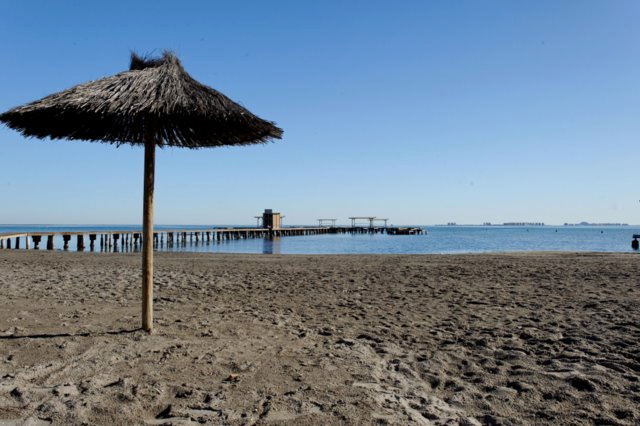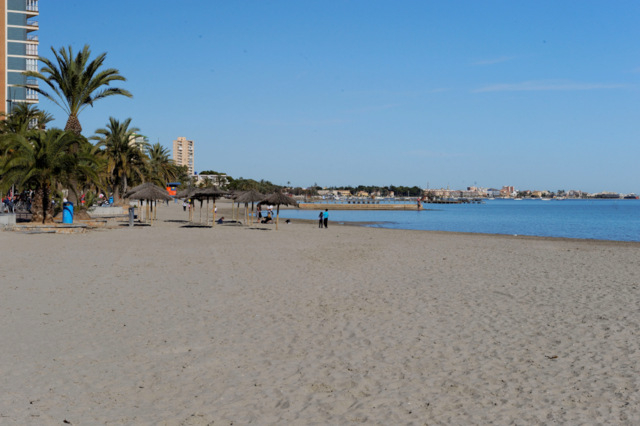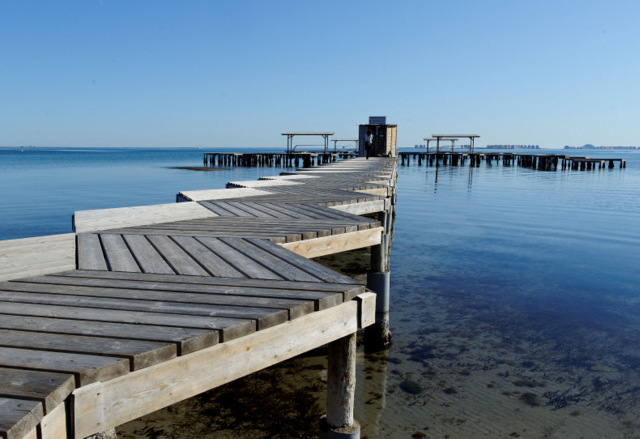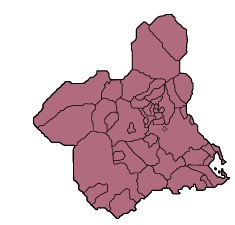San Javier beaches: Playa de Colón
A very popular Q for Quality beach on the coast of the Mar menor in Santiago de la Ribera
A glorious kilometre-long stretch of soft sand, the Paya de Colón is an important beach for those with an interest in watersports, and is in the centre of Santiago de la Ribera between the Playa del Pescador and Playa del Castillico .
At 30 metres wide it offers plenty of space, and during the summer there are hire facilities for windsurfing and dinghy sailing, as well as a windsurfing and sailing school and a canoeing centre. There are several dinghy launching pontoons, the Military Sports club also occupies a central section of the beachfront, and at the southern end of the beach is the yacht club.

The Playa de Colón also has several distinctive pontoons which provide great photo opportunities, and due to the seafront apartments and hotels and the residential streets which stretch out behind the front line towards San Javier it is very well populated in summer.
Facilities
Complementing the high usage throughout the year the beach has a range of facilities, apart from the water sports mentioned above. There are cycle racks, picnic facilities, a shaded seafront walk, children's play areas, beach bars, footwashes, beach lounger and sunshade hire and lifeguard and medical personnel on site during the summer.

Disabled facilities
The beach is particularly well adapted for disabled users, offering reserved parking spaces, several access ramps and decking up to the water's edge, cordoned bathing area, adapted changing rooms and toilets, disabled bathing seats, specially adapted shaded areas, amphibious crutches and personnel on-hand to assist carers with disabled charges.
The assisted bathing service is available from the 15th June to the 15th September, between 10:00 and 20:00 in July and August, and from 11:00 to 19:00 in June and September.
During the summer the beach is also protected by anti-jellyfish netting, and the combination of these facilities leads to it being awarded the Q for Quality flag year after year.
Shade
Behind the beach is the Paseo Marítimo which runs all the way along the seafront, offering areas of shade and seating.
Bars and Restaurants
During the summer months there is a beach bar, or chiringuito, selling a variety of drinks and snacks, and there are plenty of shops, bars and restaurants all within easy walking distance.
Parking
There is very little dedicated parking, most of the available spaces being in the streets behind the front row, in the residential areas. If driving to this beach, it may be necessary to park a few streets back during peak summer season.
There is a bus-stop nearby, which offers connections to Murcia, Alicante and Cartagena. Full details of bus services can be obtained from the tourist information office, and urban buses run to the main streets of Santiago de la Ribera behind the beach.
Beaches in Santiago de la Ribera
San Javier has two distinct sections of beaches, one being in Santiago de la Ribera on the shore of the Mar Menor, close to the main centre of San Javier town, and the other on the opposite side of the Mar Menor on the spit of land called La Manga de Mar Menor (or "the strip", as it is often referred to by holidaymakers), where there are both Mar Menor and Mediterranean beaches.

Mar Menor beaches are enclosed within the protective circle of Europe's largest saltwater lagoon, which is fed by the Mediterranean. The Mar Menor is totally unique, its geographical peculiarities creating some of the best conditions in Spain for those learning watersports, particularly windsurfing and sailing.
Murcia is the warmest mainland region in Spain, and has an average temperature of 18 degrees, which makes it perfect for year-round watersports activity, and bathers can enjoy the waters of the Mar Menor for most of the year. The water is not tidal and has only very insiginficant currents and waves, so it's perfect for family bathing or watersport beginners.
It has shallow fringes which slope gently, and is only 7 metres deep in the centre, so the water temperature is warmer than that of the Mediterranean, particularly around the edges where it is possible to wade out 50 metres from the shore and still only be waist deep.
The Mar Menor beaches are all around the lagoon, which covers a surface area of nearly 170 square kilometres, with 70 kilometres of internal coastline, separated from the Mediterranean by the 22 kilometres of La Manga. Channels known as "golas" cut across La Manga, enabling water to flow bewteen the two seas as well as making it possible for boats to sail between the two.
It is important when choosing a beach to understand that the Mar Menor beaches offer shallow and calm bathing conditions, whereas the Mediterranean beaches are wider, longer, windier, and are susceptible to wave conditions and currents.
The beaches of Santiago de la Ribera, working from south to north, are the following:
Playa de la Hita: a natural beach with no facilities next to the environmentally protected area of Islas del Mar Menor and the Camping Mar Menor park.
 Playa de Barnuevo
Playa de Barnuevo
Playa del Pescador: 280 metres long, with fine soft sand.
 Playa de Colón: a glorious kilometre-long beach, 30 metres wide, with fine sand, an important locations for watersports enthusiasts with a windsurfing and sailing school.
Playa de Colón: a glorious kilometre-long beach, 30 metres wide, with fine sand, an important locations for watersports enthusiasts with a windsurfing and sailing school.
 Playa El Castillico: 450 metres long, with an average width of 40 metres, very popular in summer.
Playa El Castillico: 450 metres long, with an average width of 40 metres, very popular in summer.
Playa del Atalayón (sailing moorings only, no beach).
Safety precautions for bathers
This is a Mar Menor beach and it is advisable to observe the following safety precautions when bathing:
- most of the Mar Menor beaches have very gently sloping shelves, meaning that bathers can walk a considerable distance from the shore and still only be waist high in the water. These shore fringes are also very warm, heating up more than the deeper waters, or the Mediterranean coastline, particularly during the hot summer months.
- many beaches are also protected by netting to exclude jellyfish. This creates safe bathing areas for families but also leads to a situation which can be life threatening, as the safety of the beaches results in many elderly bathers bathing alone. This in itself is not life threatening, but every year there are unnecessary deaths when bathers suffer a heart attack, stroke, faint or have a dizzy spell of some sort whilst bathing alone, slipping into the water without anybody else being aware that this has happened.
The transition from hot beach to cold water can shock the body, causing dizziness or fainting, so it is advisable to splash the body with water to cool down before wading out into the Mar Menor or Mediterranean.
Even though there are lifeguards at many Mar Menor beaches, accidents happen and every year there are unnecessary fatalities, the simple rule being if you have a medical condition, are taking medication, or are of advanced age, don´t bathe alone no matter how shallow and calm the water is.
And for all ages, a red flag means do not bathe, particularly on the Mediterranean beaches.
Click to see an overview of the beaches in San Javier, or to go to the home page of San Javier Today for more local news, events and other information.



 Welcome To
Welcome To San JavierLa Manga del Mar MenorSantiago de la RiberaRoda
San JavierLa Manga del Mar MenorSantiago de la RiberaRoda


 Welcome To
Welcome To San JavierLa Manga del Mar MenorSantiago de la RiberaRoda
San JavierLa Manga del Mar MenorSantiago de la RiberaRoda


 Welcome To
Welcome To San JavierLa Manga del Mar MenorSantiago de la RiberaRoda
San JavierLa Manga del Mar MenorSantiago de la RiberaRoda


 Welcome To
Welcome To San JavierLa Manga del Mar MenorSantiago de la RiberaRoda
San JavierLa Manga del Mar MenorSantiago de la RiberaRoda













